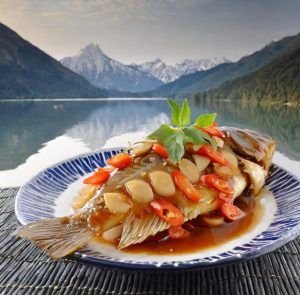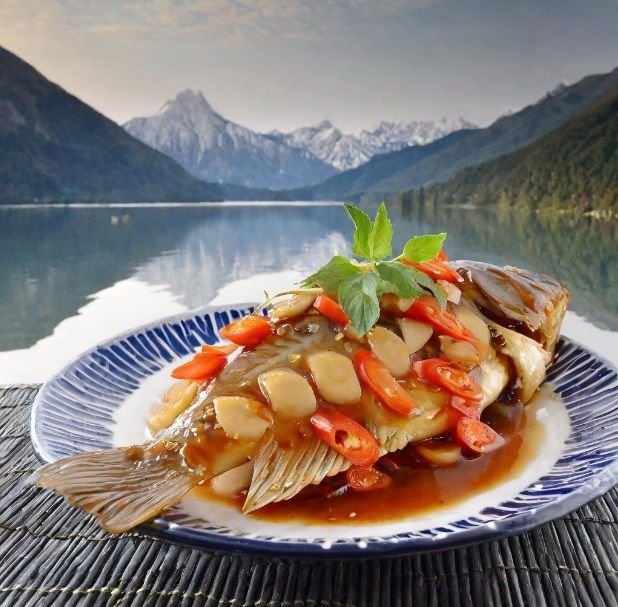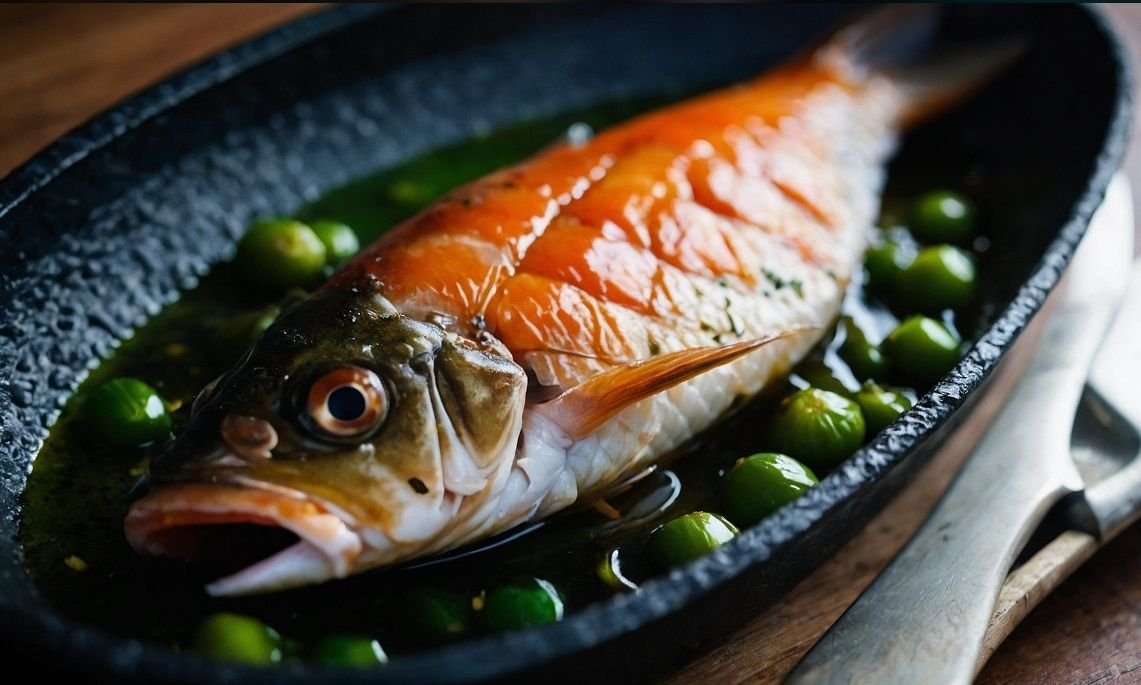Poached sweet-and-sour carp
Poached sweet and sour west lake carp
Here’s a step-by-step recipe for a classic dish from East China’s Zhejiang province, particularly popular around the West Lake area:
Ingredients:
- 2 whole carp, cleaned and scaled
- 1 cup soy sauce
- 1 cup rice vinegar
- 1 cup water
- 1 cup sugar
- 1 piece ginger, sliced
- 2 cloves garlic, minced
- 2-3 dried red chilies (optional)
- 2 tablespoons vegetable oil
- Salt to taste
- Chopped scallions and coriander for garnish
Instructions:
1. Prepare the Carp:
- Rinse the carp under cold water and pat dry with paper towels. Score both sides of the carp with shallow diagonal cuts to help it absorb the flavors of the sauce.
2. Make the Sweet-and-Sour Sauce:
- In a bowl, mix together soy sauce, rice vinegar, water, and sugar until the sugar is dissolved. This will be your sweet-and-sour sauce.
3. Poach the Carp:
- In a large skillet or wok, heat vegetable oil over medium heat. Add sliced ginger, minced garlic, and dried red chilies (if using). Sauté until fragrant, about 1-2 minutes.
- Carefully place the whole carp into the skillet or wok. Pour the sweet-and-sour sauce over the carp, ensuring it is partially submerged. Bring the sauce to a gentle simmer.
4. Simmer the Carp:
- Cover the skillet or wok and let the carp simmer gently for about 10-15 minutes, or until it is cooked through and flakes easily with a fork. Baste the carp occasionally with the simmering sauce to ensure even cooking and to infuse it with flavor.
5. Adjust Seasoning:
- Taste the sauce and adjust the seasoning with salt if needed. You can also adjust the sweetness or sourness by adding more sugar or vinegar according to your preference.
6. Garnish and Serve:
- Once the carp is cooked, carefully transfer it to a serving platter. Spoon some of the sweet-and-sour sauce over the carp and garnish with chopped scallions and cilantro for freshness and color.
7. Serve Hot:
- Serve the Poached Sweet-and-Sour West Lake Carp hot with steamed rice and your favorite vegetables or side dishes. The flavorful sauce pairs well with the delicate taste of the carp.
8. Enjoy:
- Enjoy this classic dish from East China’s Zhejiang province, known for its balance of sweet and sour flavors and tender, flaky carp. It’s a delicious and satisfying meal that captures the essence of traditional Chinese cuisine.

Trending Fish Recipes from East China: Exploring the Culinary Delights of Coastal Cuisine.
Trending recipes in the Chinese cuisine.
East China, with its long coastline and rich aquatic resources, boasts a vibrant culinary tradition centered around fish. From delicate steamed fish to flavorful braised dishes, the region offers a diverse array of fish recipes that reflect its coastal heritage and cultural diversity. In this article, we’ll explore some of the trending fish recipes from East China, highlighting their unique flavors, ingredients, and cooking techniques.
1. Sweet and Sour West Lake Carp:
- Originating from Hangzhou, the capital of Zhejiang province and home to the famous West Lake, Sweet and Sour West Lake Carp is a classic dish that epitomizes the flavors of East Chinese cuisine. The carp is poached in a sweet and tangy sauce made from vinegar, sugar, soy sauce, and spices, resulting in tender, flaky fish with a delightful balance of flavors.
2. Red-Cooked Yellow Croaker:
- Red cooking is a popular cooking technique in East China that involves braising meat or fish in a savory-sweet sauce until it develops a rich, caramelized color and flavor. Red-Cooked Yellow Croaker, made with fresh yellow croaker fish, soy sauce, sugar, ginger, and spices, is a beloved dish that showcases the region’s love for bold, aromatic flavors.
3. Steamed Mandarin Fish with Ham and Bamboo Shoots:
- Hailing from Suzhou, a city known for its elegant gardens and refined cuisine, Steamed Mandarin Fish with Ham and Bamboo Shoots is a sophisticated dish that combines delicate flavors and textures. The fish is steamed with savory Chinese ham, tender bamboo shoots, ginger, and green onions, creating a harmonious blend of savory and aromatic flavors.
4. Drunken Crab:
- In coastal regions like Shanghai and Ningbo, Drunken Crab is a popular delicacy enjoyed during the autumn months when crabs are at their peak. Fresh crabs are marinated in a mixture of Shaoxing wine, ginger, and spices, imparting a subtle sweetness and depth of flavor. The crabs are then steamed to perfection, allowing the natural sweetness of the meat to shine through.
5. Wuxi-Style Spareribs with Yellow Croaker:
- Wuxi, a city in Jiangsu province known for its rich culinary heritage, is famous for its Wuxi-Style Spareribs with Yellow Croaker. In this dish, tender spare ribs are simmered with fresh yellow croaker fish, soy sauce, rock sugar, and aromatic spices until the flavors meld together, resulting in a savory-sweet broth that is both comforting and satisfying.
6. Stir-Fried Shrimp with Longjing Tea:
- Longjing tea, also known as Dragon Well tea, is a prized variety of green tea grown in the hills surrounding Hangzhou. Stir-Fried Shrimp with Longjing Tea is a creative dish that combines succulent shrimp with the delicate aroma of Longjing tea leaves, resulting in a refreshing and aromatic dish that highlights the natural sweetness of the shrimp.
7. Braised Hairtail with Tofu and Mushrooms:
- Hairtail, a slender and flavorful fish commonly found in the waters off the coast of East China, is often braised with tofu and mushrooms to create a hearty and nutritious dish. The fish absorbs the flavors of the savory sauce, while the tofu and mushrooms add texture and depth to the dish, making it a favorite among seafood lovers.
From the bustling metropolis of Shanghai to the tranquil water towns of Suzhou, East China offers a treasure trove of fish recipes that showcase the region’s rich culinary heritage and diverse flavors.
Whether it’s the sweet and sour notes of West Lake Carp or the aromatic spices of Red-Cooked Yellow Croaker, each dish tells a story of tradition, innovation, and the timeless allure of coastal cuisine. As these trending fish recipes continue to captivate palates and inspire chefs around the world, they serve as a testament to the enduring legacy of East Chinese culinary excellence.

Chinese poaching technique
The Chinese poaching technique, also known as “水煮” (shuǐzhǔ) or “水煮泡” (shuǐzhǔ pào), is a traditional cooking method that involves gently simmering ingredients in a flavorful broth or seasoned liquid. This technique is widely used in Chinese cuisine to cook delicate proteins such as fish, chicken, and tofu, as well as vegetables.
Key Steps in the Chinese Poaching Technique:
- Prepare the Poaching Liquid: In Chinese poaching, the liquid used for poaching is often a combination of water, aromatics, and seasonings. Common ingredients include ginger, scallions, garlic, soy sauce, rice wine, and sometimes sugar or rock sugar for sweetness. The poaching liquid is brought to a gentle simmer, infusing the ingredients with flavor.
- Select and Prepare the Ingredients: Choose ingredients that are suitable for poaching, such as thinly sliced fish fillets, chicken breast, or tofu. The ingredients may be marinated briefly in soy sauce, rice wine, and aromatics before poaching to enhance their flavor.
- Poach the Ingredients: Once the poaching liquid is simmering, carefully add the ingredients to the pot. It’s important to maintain a gentle simmer throughout the poaching process to ensure that the proteins cook gently and evenly without becoming tough or overcooked.
- Control the Cooking Time: The cooking time will vary depending on the type and thickness of the ingredients. Fish fillets may only need a few minutes to cook through, while chicken breast or tofu may require slightly longer. It’s essential to monitor the cooking process closely to prevent overcooking.
- Test for Doneness: To determine if the ingredients are cooked through, use a fork or chopstick to pierce the thickest part of the protein. It should flake easily for fish or be firm yet tender for chicken or tofu.
- Serve and Enjoy: Once the ingredients are cooked to perfection, carefully remove them from the poaching liquid and arrange them on a serving platter. The poaching liquid can be strained and served as a light sauce or broth alongside the dish. Garnish with fresh herbs, such as coriander or green onions, for added flavor and visual appeal.
Benefits of Chinese Poaching Technique:
- Retains Moisture and Flavor: The gentle poaching process helps to retain the natural moisture and flavor of the ingredients, resulting in tender and succulent dishes.
- Infuses Flavor: The ingredients absorb the aromatics and seasonings from the poaching liquid, enhancing their taste and aroma.
- Healthy Cooking Method: Chinese poaching requires minimal fat or oil, making it a healthier cooking method compared to frying or deep-frying.
- Versatile: Chinese poaching can be used with a variety of proteins and vegetables, allowing for endless culinary creativity and versatility.
In summary, the Chinese poaching technique is a classic cooking method that produces tender, flavorful dishes with minimal fuss. Whether you’re cooking fish, chicken, or tofu, mastering this technique will elevate your Chinese cuisine repertoire and delight your taste buds with its delicate flavors and textures.

Coriander in Chinese Cuisine: Exploring the Vibrant Flavors of an Essential Herb
Coriander, also known as Chinese parsley or cilantro, is a staple herb in Chinese cuisine, renowned for its fresh and citrusy flavor profile. Widely used in both fresh and dried forms, coriander plays a vital role in enhancing the taste, aroma, and visual appeal of many Chinese dishes. In this article, we will delve into the rich culinary heritage of coriander in Chinese cuisine, exploring its usage, cultural significance, health benefits, and culinary versatility.
1. Historical and Cultural Significance:
- Coriander has been cultivated and used in Chinese cuisine for thousands of years, dating back to ancient times. It is believed to have originated in the Mediterranean region and was introduced to China along the ancient Silk Road trade route.
- In Chinese culture, coriander is highly prized for its aromatic leaves and seeds, which are valued not only for their culinary properties but also for their medicinal and symbolic significance. It is often associated with prosperity, good fortune, and purification rituals.
2. Culinary Usage and Applications:
- Fresh coriander leaves are commonly used as a garnish or finishing touch in Chinese dishes, adding a burst of color, freshness, and citrusy flavor. They are often sprinkled over soups, salads, stir-fries, noodles, and rice dishes just before serving.
- Coriander roots are also used in Chinese cuisine and are particularly prized for their intense flavor. They are often crushed or minced and added to marinades, sauces, and soups to impart a deep, earthy flavor.
- Coriander seeds are a common ingredient in Chinese spice blends and are used whole or ground to add warmth, complexity, and depth of flavor to dishes. They are often toasted or dry-roasted before use to enhance their aroma and release their essential oils.
3. Popular Coriander-Based Dishes:
- Hot and Sour Soup: Fresh coriander leaves are a classic garnish for this beloved Chinese soup, adding a bright and herbaceous note to the tangy and flavorful broth.
- Sichuan Dan Dan Noodles: Coriander leaves are often used as a garnish for this spicy and savory noodle dish, providing a refreshing contrast to the rich and fiery sauce.
- Steamed Fish with Ginger and Scallions: Fresh coriander leaves are used to garnish this delicate and aromatic fish dish, adding a pop of color and freshness to the tender and flavorful fish fillets.
4. Health Benefits of Coriander:
- Coriander is rich in vitamins, minerals, and antioxidants, making it a nutritious addition to your diet. It is particularly high in vitamin K, vitamin C, and potassium, which are essential for bone health, immune function, and heart health.
- Coriander is also believed to have anti-inflammatory, antimicrobial, and digestive properties, which may help promote gastrointestinal health, reduce inflammation, and support overall well-being.
- Additionally, coriander contains phytonutrients and antioxidants such as quercetin, kaempferol, and beta-carotene, which have been linked to various health benefits, including reduced risk of chronic diseases such as heart disease, cancer, and diabetes.
5. Culinary Tips and Tricks:
- When using fresh coriander leaves, be sure to wash them thoroughly and pat them dry before use to remove any dirt or debris. Trim any wilted or discolored leaves before adding them to your dishes.
- To maximize the flavor of coriander seeds, dry-toast them in a hot skillet or pan for a few minutes until fragrant before grinding or using them in your recipes. This will enhance their aroma and release their essential oils.
- Experiment with different parts of the coriander plant, including the leaves, stems, roots, and seeds, to explore the full range of flavors and textures that this versatile herb has to offer.
In conclusion, coriander is a cherished ingredient in Chinese cuisine, prized for its vibrant flavor, aroma, and health benefits. Whether used as a garnish, seasoning, or main ingredient, coriander adds depth, complexity, and freshness to a wide variety of Chinese dishes, making it an essential herb in every Chinese kitchen.
So the next time you’re cooking Chinese food, don’t forget to reach for the coriander and elevate your culinary creations with its unique and delightful flavor profile.

Ginger: The Magic Ingredient in Chinese Cuisine
Ginger, known scientifically as Zingiber officinale, is a versatile and widely used spice in Chinese cuisine. With its distinctive flavor profile and numerous health benefits, ginger has earned its place as a staple ingredient in Chinese cooking. In this article, we’ll explore the rich culinary heritage of ginger in Chinese cuisine, its cultural significance, culinary applications, health benefits, and culinary tips.
1. Cultural Significance:
- Ginger has been an integral part of Chinese culinary and medicinal traditions for thousands of years. It is believed to have originated in Southeast Asia and was introduced to China over 2,000 years ago. Since then, it has become deeply ingrained in Chinese culture and cuisine, valued for its flavor, aroma, and medicinal properties.
- In traditional Chinese medicine (TCM), ginger is considered a warming and invigorating herb that helps to improve digestion, boost circulation, and relieve various ailments such as nausea, colds, and inflammation. It is often used in herbal remedies, teas, and tonics to promote health and well-being.
2. Culinary Applications:
- Fresh Ginger: Fresh ginger root is used extensively in Chinese cuisine to add flavor, aroma, and heat to a wide variety of dishes. It can be sliced, minced, grated, or julienned and used in stir-fries, soups, sauces, marinades, and steamed dishes.
- Ground Ginger: Ground ginger powder is also used in Chinese cooking, particularly in spice blends and seasoning mixes. It adds warmth, depth, and complexity to dishes and is often used in marinades, rubs, and baked goods.
- Pickled Ginger: Pickled ginger, also known as “gari” in Japanese cuisine, is a popular condiment served with sushi and sashimi. In Chinese cuisine, pickled ginger is less common but is sometimes used as a palate cleanser or garnish for rich and fatty dishes.
3. Culinary Diversity:
- Ginger is used in a wide range of Chinese dishes, from savory stir-fries and soups to sweet desserts and beverages. Its versatility allows it to complement a variety of ingredients and flavor profiles, making it a favorite among chefs and home cooks alike.
- In Cantonese cuisine, ginger is often used to flavor seafood dishes such as steamed fish and crab, as well as savory soups and broths. Its pungent and spicy flavor helps to balance the richness of the seafood.
- In Sichuan cuisine, ginger is used in spicy and aromatic dishes such as mapo tofu, hot pot, and kung pao chicken. Its warming properties complement the bold flavors of Sichuan peppercorns and chili peppers, adding depth and complexity to the dishes.
4. Health Benefits:
- Ginger is packed with bioactive compounds and nutrients that offer a range of health benefits. It contains gingerol, a powerful anti-inflammatory and antioxidant compound that may help reduce inflammation, lower the risk of chronic diseases, and boost immune function.
- Studies have shown that ginger may help alleviate nausea, motion sickness, and morning sickness during pregnancy. It is also commonly used to relieve digestive discomfort, including indigestion, bloating, and gas.
- Additionally, ginger has been found to have antimicrobial and anti-cancer properties, although more research is needed to fully understand its potential health benefits.
5. Culinary Tips:
- When selecting fresh ginger, look for roots that are firm, plump, and free of wrinkles or mold. Avoid ginger that is soft, shriveled, or has moldy spots.
- To peel ginger, use the edge of a spoon or a vegetable peeler to remove the thin, papery skin. Alternatively, you can scrape off the skin with the back of a knife.
- To maximize the flavor of ginger, slice it thinly against the grain or grate it using a fine grater or microplane. Crushing or bruising the ginger before using it can also release more of its aromatic oils.
In Chinese cuisine, ginger is much more than just a spice – it’s a magic ingredient that adds depth, complexity, and warmth to a wide variety of dishes. Whether used fresh, ground, or pickled, ginger plays a vital role in enhancing the flavor, aroma, and nutritional value of Chinese cuisine. So the next time you’re cooking Chinese food, don’t forget to reach for the ginger and unlock its culinary magic in your kitchen.




